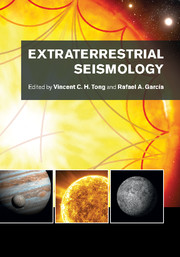Book contents
- Frontmatter
- Contents
- List of contributors
- Preface
- Acknowledgements
- List of abbreviations
- Planetary seismology: High risk, high return
- A bright outlook for helio- and asteroseismology
- Part I Observation and space missions
- Part II Data and physical parameters
- Part III Modeling approaches
- Part IV Discoveries of physical structures and processes
- Part V Interdisciplinary research involving planetary and astrophysical sciences
- 16 Diskoseismology of accretion disks
- 17 Numerical simulations of magnetoconvection and helioseismology
- 18 Impact seismology on terrestrial and giant planets
- 19 Angular momentum transport in stars: From short to long time scales
- 20 From the Sun to the distant stars, and back: Future research directions
- 21 Stellar dynamics: Rotation, convection, and magnetic fields
- 22 Sunquakes: Helioseismic response to solar flares
- 23 Seismic waves in small bodies: Sources and propagation
- Part VI Interdisciplinary research involving terrestrial seismology
- References
- Index
20 - From the Sun to the distant stars, and back: Future research directions
from Part V - Interdisciplinary research involving planetary and astrophysical sciences
Published online by Cambridge University Press: 05 July 2015
- Frontmatter
- Contents
- List of contributors
- Preface
- Acknowledgements
- List of abbreviations
- Planetary seismology: High risk, high return
- A bright outlook for helio- and asteroseismology
- Part I Observation and space missions
- Part II Data and physical parameters
- Part III Modeling approaches
- Part IV Discoveries of physical structures and processes
- Part V Interdisciplinary research involving planetary and astrophysical sciences
- 16 Diskoseismology of accretion disks
- 17 Numerical simulations of magnetoconvection and helioseismology
- 18 Impact seismology on terrestrial and giant planets
- 19 Angular momentum transport in stars: From short to long time scales
- 20 From the Sun to the distant stars, and back: Future research directions
- 21 Stellar dynamics: Rotation, convection, and magnetic fields
- 22 Sunquakes: Helioseismic response to solar flares
- 23 Seismic waves in small bodies: Sources and propagation
- Part VI Interdisciplinary research involving terrestrial seismology
- References
- Index
Summary
Introduction
Until recently our knowledge of stellar structure and evolution was based almost exclusively on observations of the superficial characteristics of stars, i.e., their surface temperature, gravity, and composition, in some cases combined with the surface luminosity, and in relatively rare cases observational determinations of radii and masses, with observations of eclipsing binaries providing accurate information (e.g., Andersen, 1991). This was combined with modeling, allowing us to infer from these surface properties the structure of the interior of a star, including its evolutionary state and hence age. In a few binary systems it is possible to determine the apsidal motion, which provides a measure of the internal mass distribution (e.g., Claret and Giménez, 2010). Also, in the unique case, amongst non-exploding stars, of the Sun, observations of neutrinos provide information about the nuclear reactions in the stellar interior (for a recent review, see Turck-Chièze and Couvidat, 2011), although these were for a long time at variance with the observations.
Thus, observations only provide somewhat indirect information on which to base a test of our modeling and understanding of stellar evolution. This is a serious concern. Stars are evidently very complex systems, controlled by atomic processes and interactions in the thermodynamic properties of stellar matter, interactions between matter and radiation, and nuclear energy generation that are far from understood or yet reproduced in a controlled manner in the laboratory. Also, they have hydrodynamic instabilities, including those potentially associated with rotation, which are at best treated in a rudimentary fashion in the modeling, but which probably have substantial effects on the evolution of stars. Magnetic fields, which are present on large scales in some stars and which are evident in solar and stellar activity, add another layer of complexity in the physics of stars that is rarely even considered in the modeling.
- Type
- Chapter
- Information
- Extraterrestrial Seismology , pp. 276 - 293Publisher: Cambridge University PressPrint publication year: 2015
- 1
- Cited by



